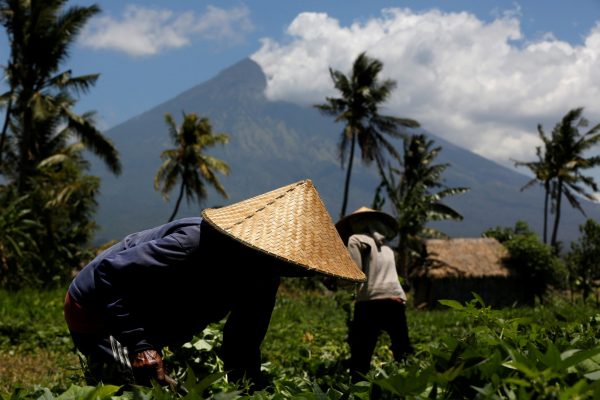These are indeed issues facing Indonesia’s commercial agricultural sector and associated agribusiness. They are worthy of discussion. But they are not the main problems of Indonesian farmers. As in the rest of Asia, Indonesian agriculture is dominated by smallholders. Their problems are poverty and indebtedness.
A universal feature of growing economies is the decline of agriculture as a share of both GDP and total employment. There are two principal causes for this long-term process of structural change.
The first (and best understood) operates on the demand side: as real incomes rise, consumers allocate an increasing share of their total budgets to non-food items, such as manufactured goods and services, and a declining share to food. The declining demand for agricultural output as a share of total demand squeezes resources out of agriculture.
A second (and less understood) contributor operates on the supply side. As capital accumulates relative to labour at the economy-wide level, full employment of both capital and labour requires that more capital-intensive economic sectors expand at the expense of more labour-intensive sectors. As the more capital-intensive sectors expand they require additional workers, which they obtain by drawing labour from agriculture.
Indonesia’s experience of structural change is typical in this regard. Between 1980 and 2016, the share of agriculture in Indonesia’s GDP contracted from 23 per cent to 13 per cent. At the same time, the share of agriculture in Indonesia’s total employment contracted from 55 per cent to 32 per cent.
In Indonesia, as in most other growing economies in Asia, agriculture’s GDP share is far below its employment share, and this disparity has persisted over time. Since GDP share translates to income share, income per worker has remained substantially lower in agriculture than in other sectors. This explains why so many Indonesians and others elsewhere in Asia have left agriculture to look for work elsewhere.
Since the 1970s, Indonesia’s absolute levels of poverty incidence have declined markedly in both urban and rural areas. But the remaining poor are increasingly concentrated in rural areas. Agricultural workers are becoming even more impoverished relative to those employed elsewhere because the sectoral structure of employment is not adjusting rapidly enough to keep pace with the shifting sectoral structure of incomes. Agricultural workers are exiting farming too slowly.
Those workers who remain in agriculture struggle to maintain their incomes relative to those employed in the expanding sectors of the economy. The problem is not that farmers lack skills, but that those skills are not highly valued by the market economy.
As the more mobile workers exit smallholder farming, those who remain are increasingly individuals whose economic options outside of agriculture are limited, such as the old and the very young. Males have also been more likely to leave, meaning that the farming workforce increasingly consists of women, and especially older women.
This simple account helps to explain why lower living standards and poverty incidence continue to be concentrated in Indonesia’s rural areas. Farmers are poor primarily because there are too many of them relative to the market value of their output, and because those who remain are increasingly people who are unable to leave. The greatest single problem of Indonesian agriculture is not that too little food is being produced, but that too many people are engaged in producing it at low levels of economic productivity and income.
Agricultural protectionism, the policy thrust for which the Indonesian Farmers Association is best known, is not the solution. Raising domestic food prices by restricting imports does little or nothing for poor farmers. Smallholder farmers sell unprocessed products such as paddy rice — goods that are not traded internationally and receive limited direct benefit from protectionism.
Higher domestic food prices also harm many poor farmers, since a surprisingly high proportion of smallholders are net buyers of food. Agricultural protectionism serves to benefit those farmers who sell the most — agribusiness and the largest farmers — at the expense of the poorest consumers.
How could the problems of Indonesia’s smallholder farmers be addressed? Over the long term, improving the economic mobility of rural people must be central to the solution. Upgrading the quantity and quality of resources devoted to education within rural areas is imperative. By raising the productivity of rural people, better education means that those who do migrate to urban areas in search of a better life are not condemned to the bottom of the economic pile.
But this approach will take time, is costly and the benefits will not be apparent within the terms of democratically elected governments. Farmers who are already old will not benefit directly at all.
More immediate solutions are also needed. Progress in information technology means that direct income support for the poorest people (increasingly meaning poor farming people) has become administratively feasible. There are many practical difficulties involved, but Indonesia has been a pioneer in developing this policy option in conjunction with the World Bank.
Seemingly, none of this is contained in the agenda of the Indonesian Farmers Association.
Peter Warr is the John Crawford Professor of Agricultural Economics, Emeritus, at The Australian National University.

